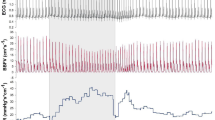Abstract
The aim of this study was to compare the changes in forearm vascular resistance that occurred during orthostatic stress in asymptomatic volunteer subjects with those in patients with posturally related syncope. The authors hoped firstly that it would indicate the importance of vasoconstriction in the maintenance of blood pressure, and secondly that it might have diagnostic value if there were differences between symptomatic patients and asymptomatic volunteers. Twelve volunteers and 67 patients with unexplained syncope were classified as early or late fainters, based on their endurance of a test of combined head-up tilting and lower-body suction. Responses of vascular resistance were assessed from the ratio of arterial blood pressure (Finapres) to brachial artery blood velocity (Doppler). Changes in vascular resistance were greater in volunteers at all stages of the procedure than in patients. There was, however, no significant difference between the responses of early and late-fainting volunteers. These results demonstrate the importance of vasoconstriction in the resistance to posturally related syncope, and they indicate that assessments of responses of vascular resistance may improve the accuracy of the diagnosis.
Similar content being viewed by others
References
Hainsworth, R, Al-Shamma YMH. Cardiovascular responses to head-up tilting in healthy subjects.Clin Sci 1988; 74:17–22.
Sharpey-Schafer EP. Emergencies in general practice: syncope.Br Med J 1956; i:506–509.
Kapoor WN, Smith, MA, Miller NL. Upright tilt testing in evaluating syncope: a comprehensive literature review.Am J Med 1994; 97:78–88.
Stevens PM, Lamb LE. Effects of lower body negative pressure on the cardiovascular system.Am J Cardiol 1965; 16:506–515.
Grubb, BP, Temesy-Armos P, Hahn H, Elliot L. Utility of upright tilt-table testing in the evaluation and management of syncope of unknown origin.Am J Med 1991; 90:6–10.
Almquist A, Goldenberg IF, Milstein S, Chen MY, Chen X, Hansen R,et al. Provocation of bradycardia and hypotension by isoproterenol and upright posture in patients with unexplained syncope.N Engl J Med 1989; 320:346–351.
Waxman MB, Yao L, Cameron DA, Wald RW, Roseman J. Isoproterenol induction of vasodepressor-type reaction in vasodepressor-prone persons.Am J Cardiol 1991; 63:58–65.
Kapoor WN, Brant N. Evaluation of syncope by upright tilt testing with isoproterenol: a nonspecific test.Ann Int Med 1992; 116:358–363.
El-Bedawi KM, Hainsworth R. Combined head-up tilt and lower body suction: a test of orthostatic tolerance.Clin Auton Res 1994; 4:41–47.
Hainsworth R, El-Bedawi KM. Orthostatic tolerance in patients with unexplained syncope.Clin Auton Res 1994; 4:239–244.
El-Sayed H, Hainsworth R. Relationship between plasma volume, carotid baroreceptor sensitivity and orthostatic tolerance.Clin Sci 1995; 88:463–470.
Brown CM, Hainsworth R. Assessment of capillary fluid shifts during orthostatic stress in healthy subjects and patients with syncope.Clin Auton Res 1999; 9:69–73.
Hagan RD, Diaz FJ, Horvath SM. Plasma volume changes with movement to supine and standing position.J Appl Physiol 1978; 45:414–418.
Tarazi RC, Melscher HJ, Dustan HP, Frohlich ED. Plasma volume changes with upright tilt: studies in hypertension and syncope.J Appl Physiol 1970; 28:121–126.
Brigden W, Howarth S, Sharpey-Shafer EP. Postural changes in the peripheral blood-flow of normal subjects with observations on vasovagal fainting reactions as a result of tilting, the lordotic posture, pregnancy and spinal anaesthesia.Clin Sci 1950; 9:79–90.
Hainsworth R, Al-Shamma YMH. Cardiovascular responses to upright tilting in healthy subjects. Clin Sci 1988; 74:17–22.
Tschakovsky ME, Shoemaker JK, Hughson RL. Beat-by-beat forearm blood flow with Doppler ultrasound and strain-gauge plethysmography.J Appl Physiol 1995; 79:713–719.
Shoemaker JK, Pazeg ZI, Hughson RL. Forearm blood flow by Doppler ultrasound during rest and exercise: tests of day-to-day repeatability.Med Sci Sports Exerc 1996; 28:1144–1149.
Stevens PM. Cardiovascular dynamics during orthostasis and influence of intravascular instrumentation.Am J Cardiol 1966; 17:211–218.
Kerslake DM. The effect of the application of an arterial occlusion cuff to the wrist on the blood flow in the human forearm.J Physiol 1948; 108:451–457.
Barcroft H, Edholm OG. On the vasodilatation in human skeletal muscle during post-haemorrhagic fainting.J Physiol 1945; 104:161–175.
McIntosh SJ, Lawson J, Kenny RA. Intravenous cannulation alters the specificity of head-up tilt testing for vasovagal syncope in elderly patients.Age Ageing 1994; 23:317–319.
Gaskell P, Burton AC. Local postural vasomotor reflexes arising from the limb veins.Circ Res 1953; 1:27–39.
Barcroft H, McMichael J, Sharpey-Shafer EP. Post haemorrhagic fainting. Study by cardiac output and forearm flow.Lancet 1944;i:489–491.
Sneddon JF, Counihan PJ, Bashir Y, Haywood GA, Ward DE, Camm AJ. Impaired immediate vasoconstrictor responses in patients with recurrent neurally mediated syncope.Am J Cardiol 1993; 71:72–76.
DeJong CCE, van Steenwijk V, Wieling W, Johannes JM, Harms MP, Kuis W,et al. Incidence and hemodynamic characteristics of near-fainting in healthy 6 to 16 year old subjects.J Am Coll Cardiol 1995; 25:1615–1621.
Novak V, Honos G, Schondorf R. Is the heart ‘empty’ at syncope.J Auton Nerv Syst 1996; 60:83–92.
Author information
Authors and Affiliations
Rights and permissions
About this article
Cite this article
Brown, C.M., Hainsworth, R. Forearm vascular responses during orthostatic stress in control subjects and patients with posturally related syncope. Clinical Autonomic Research 10, 57–61 (2000). https://doi.org/10.1007/BF02279892
Received:
Accepted:
Issue Date:
DOI: https://doi.org/10.1007/BF02279892




